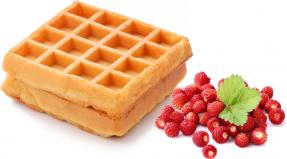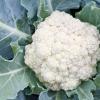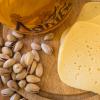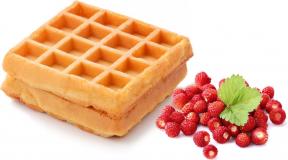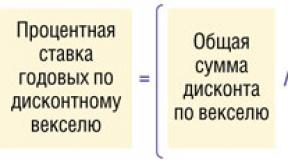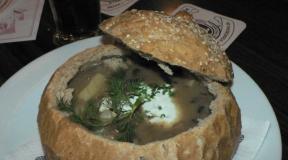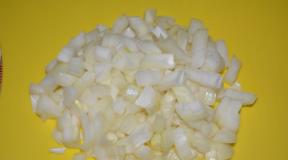Calories in cauliflower. What are the benefits of cauliflower?
Kira Stoletova
Cauliflower is an annual crop with a fibrous root system. It is used in cooking as a base or addition when preparing a dish. The calorie content of cauliflower depends on the method of processing the product, as well as the variety and subspecies.

Composition and nutritional value
The calorie content of cauliflower per 100 g of product is 23.4 kilocalories. This is 1.56% of the daily value.
Nutritional value of cauliflower:
- proteins - 1.9 g;
- fats - 0.4 g;
- carbohydrates - 4.2 g;
- water - 95.4 g;
- dietary fiber - 2.2 g;
Vitamin Composition:
- vitamin A (VE);
- vitamin B1 (thiamine);
- vitamin B4 (choline);
- vitamin B9 (folate substances);
- vitamin B2 (riboflavin);
- vitamin B5 (panthethonic acid);
- vitamin B6 (pyridoxine);
- beta-carotene;
- vitamin PP (NE);
- lutein;
- vitamin C (ascorbic acid);
- vitamin K (phylloquinone);
- betaine;
- vitamin E (alfatocopherol).
Mineral composition
Macronutrients in cauliflower:
- potassium;
- phosphorus;
- magnesium;
- calcium;
- sodium.
Composition of microelements:
- zinc;
- copper;
- fluorine;
- manganese;
- selenium.
The vegetable also contains digestible carbohydrates. The portion of mono and disaccharides is 1.93 g. The low amount of calories per 100 g of product makes cabbage useful for weight loss. Also, its rich mineral composition allows it to be used as a substitute for vitamin complexes without the risk of obesity.
Cauliflower acids

Composition of essential amino acids:
- lysine;
- threonine;
- phenylalanine;
- arginine;
- leucine;
- valine;
- tryptophan.
Composition of nonessential amino acids:
- proline;
- alanine;
- glutamic acid;
- serine;
- cisterine;
- aspartic acid.
Fatty acid:
- omega 3;
- Omega 6.
Saturated acids:
- palmatic acid;
- stearic acid.
Mono and polyunsaturated fatty acids:
- oleic acid;
- linolenic;
- linoleic
Nutritional value of cabbage dishes
Calories of cooked cauliflower per 100 g of product:
- boiled - 28.7 kcal;
- fried - 123 kcal;
- steamed - 32.3 kcal;
- with chicken eggs - 55.32 kcal;
- in batter - 77.85 kcal;
- with sour cream - 53.45 kcal.
Nutritional value of boiled cauliflower:
- proteins - 1.83 g;
- fats - 0.28 g;
- carbohydrates - 3.73 g;
Nutritional value of fried vegetable:
- proteins - 3.22 g;
- fats - 11.23 g;
- carbohydrates - 5.64 g.
Nutritional value of steamed cauliflower:
- proteins - 2.35 g;
- fats - 0.28 g;
- carbohydrates - 4.75 g.
Nutritional value of the colored variety in batter (g):
- proteins - 5.32;
- fats - 4.54;
- carbohydrates - 4.33.

Nutritional value of cauliflower with sour cream (g):
- proteins - 2.54;
- fats - 6.654;
- carbohydrates - 4.65.
Nutritional value of the colored variety with egg (g):
- proteins - 3.22;
- fats - 2.56;
- carbohydrates - 5.43.
Cauliflower in cooking
It is forbidden to cook the colored variety in dishes made of iron or aluminum. This will cause a chemical reaction with the acids contained in the product, which will reduce the usefulness of the vegetable.
Cauliflower with salt
The low calorie content of cauliflower opens up well when cooked with salt. This method increases the effect of vitamins B, C and K, and also improves the body's absorption of dietary fiber and sodium.
Useful properties of cabbage with salt:
- Improving metabolism. Vitamins B6 and C9 act as enzymes in metabolic processes.
- Oxidative-regenerative effects. Vitamin C fortified with salt improves the immune system and accelerates the body's absorption of microelements from cabbage. It also prevents gum disease and cracking of blood capillaries.
- Regulating blood quality. Vitamin K prevents blood clotting and eliminates blood clots.
Cauliflower for weight loss
The low calorie content of cauliflower makes the product one of the most effective for weight loss. There is a diet that involves eating vegetables as the basis of the diet. Monoration weight loss is effective, but extreme. Such diets are carried out in short courses.
Products with which cabbage is combined for weight loss:
- cucumbers;
- buckwheat;
- watermelons.
The vegetable makes a good basis for a menu, due to its low calorie content and a large number of useful microelements. The fruits also contain folic acid, which normalizes carbohydrate metabolism and prevents the appearance of fatty deposits.
Three-day cabbage diet
To carry out a three-day weight loss program on the colored variety, you need to prepare 5 kg of fruits. They consume 1.5-1.7 kg per day. The product is boiled in salted water and divided into 3-4 servings, which are distributed evenly throughout the day. In 3 days it is possible to lose 1.5-3 kg.
Also, such a diet is carried out to switch to constant consumption of low-calorie foods. After 3 days, it is better to switch to buckwheat and watermelon porridges, which are supplemented with fruits and vegetables.
Contraindications to the cabbage diet
Large amounts of cauliflower should not be consumed if:
- increased stomach acidity;
- intestinal cramps;
- acute form of ulcer;
- enterocolitis;
- gout;
- liver and kidney disease;
- high blood pressure.
Cauliflower is contraindicated in the postoperative period. The product is also prohibited if you have an individual intolerance.
Due to the large amount of purine, the vegetable causes stagnation of uric acid, which can cause gout. The product also has a negative effect on the thyroid gland, so it is forbidden to eat a lot of vegetables if this organ has disorders.
Conclusion
The low calorie content of cauliflower per 100 g and a large number of beneficial properties allows the product to be used for auxiliary treatment. It is able to replace vitamin and mineral complexes without the risk of weight gain.
Diabetics are also allowed to consume the vegetable. Its glycemic index is 15.
Cauliflower belongs to the annual plants of the cabbage family. The product is valued for its delicate taste and beneficial properties. The name of the vegetable is due to the fact that in nature there are heads of cabbage with purple, yellow, white and green inflorescences. White cabbage is the most common. It consists of a large head of cabbage with small inflorescences. In cross-section, the head of cabbage looks like a branched tree. The fresh product is elastic, crispy with a delicate aroma. When choosing cauliflower, you should pay attention to ensure that there are no dark spots on it and that the leaves are fresh.
IT IS IMPORTANT TO KNOW! Fortune teller Baba Nina:“There will always be plenty of money if you put it under your pillow...” Read more >>
- vitamins of group B, PP, K, H, E, which help the body work at 100%;
- calcium, magnesium, sodium, potassium, phosphorus, iron, zinc, copper, manganese, selenium, cobalt, iodine, chlorine;
- vegetable protein, which is contained in the product in large quantities and can easily replace animal protein;
- vegetable acids;
- alimentary fiber;
- pectin.
- normalization of the digestive system;
- normalization of stool;
- providing the body with the daily norm of vitamin B, C and iron;
- elimination of inflammatory processes;
- increasing the protective functions of the body;
- lowering cholesterol levels;
- maintaining the cardiovascular system;
- improving the functioning of the circulatory system.
- enterocolitis;
- ulcer;
- gastritis during exacerbation;
- surgical intervention in the abdominal cavity;
- individual intolerance;
- gout.
- provide the growing body with all the necessary nutrients;
- provide the baby’s body with vegetable protein, which is absorbed better than animal protein;
- restore the functioning of the digestive system;
- improve the condition of the nervous and endocrine systems.
Show all
Chemical composition and calorie content
The dietary product contains a large number of macro- and microelements. Cauliflower contains:
Calorie content per 100 g of product depends on the type of preparation of cabbage:
In its raw form, the product is low in calories, which allows it to be used in dietary nutrition; cabbage is suitable for the diet of young children due to its high protein content and ease of digestibility. KBJU for weight loss should be calculated depending on the type of preparation of the vegetable.
Table of BZHU per 100 g of fresh product:
The vegetable has many beneficial properties, but if consumed excessively, it can harm the body.
Benefits and harm to the body
The benefits of curly cabbage are as follows:
If consumed in excess, cabbage can cause serious harm to human health. Contraindications include the presence of pathologies and conditions such as:
Before consuming the product, you should consult a nutritionist if there are contraindications.

Impact on the male body
Men should definitely introduce kale into their diet after 40 years of age. At this age, the risk of developing heart and vascular diseases increases. Cauliflower reduces the risk of heart attack and stroke, lowers bad cholesterol levels, and prevents the formation of thrombosis.
To prevent the appearance of prostatitis, it is enough to eat 150 g of the product per day. Regular consumption of vegetables reduces the risk of disease several times. The product protects the prostate gland from cancer.
To get rid of a beer belly, a man just needs to eat 100 g of boiled vegetable for dinner. It is better not to add additional components to it except salt.
The medicinal properties of the vegetable help restore a man’s body and psycho-emotional background after a hard day at work.

Vegetable for women
Cauliflower can be included in the diet to combat excess weight, while oea helps provide the body with all the necessary nutrients.
It is recommended to include the vegetable in the daily diet for women suffering from painful menstruation and gynecological diseases. Cauliflower copes well with pain and inflammatory processes.
During pregnancy, you can eat the vegetable instead of the main side dish. It helps get rid of edema and actively participates in the formation of the baby’s nervous system and brain. Helps maintain optimal weight for the expectant mother and has a beneficial effect on the kidneys.
Product for children's nutrition
Cauliflower is one of the first complementary foods for children. It is often introduced into a child’s diet along with broccoli. These two types of vegetables can be introduced in the form of vegetable puree from 4 months of age.

Cauliflower and broccoli (green)
The product helps:
Cauliflower is quickly absorbed by the body; it should be introduced into the baby’s diet gradually, starting with 1 spoon.
Cooking recipes
There are many recipes for preparing various dishes based on cauliflower. The easiest way to cook boiled vegetables. This dish contains a minimum of calories and is suitable for dietary nutrition.
Cooking recipe: Separate the cauliflower into florets and throw into boiling salted water. Boil the vegetable for 5-10 minutes, then drain the water. Before serving, you can sprinkle the product with herbs or add a piece of butter, which will certainly add calories to the dish.
Cabbage can be stewed in cream. To do this, you need to lightly fry the inflorescences in butter, pour in cream and simmer for 15 minutes. At the end of cooking, add spices to taste. If desired, you can reduce the cooking time by 5 minutes, transfer the vegetable to a baking dish, sprinkle with cheese and place in the oven for 5 minutes. Bake at 200 degrees. Stewed cabbage in cream is good as an independent dish, eaten for dinner.
The simplest thing is to fry the vegetable in batter. To prepare it, just take 1 large spoon of milk, 1 egg, salt, pepper. Mix all ingredients and beat with a fork. Divide the curly vegetable into inflorescences, rinse, dry and dip in batter. Fry in a heated frying pan with sunflower oil.
And a little about secrets...
The story of one of our readers, Inga Eremina:
I was especially depressed by my weight; at 41, I weighed as much as 3 sumo wrestlers combined, namely 92 kg. How to completely lose excess weight? How to cope with hormonal changes and obesity? But nothing disfigures or makes a person look younger than his figure.
But what can you do to lose weight? Laser liposuction surgery? I found out - no less than 5 thousand dollars. Hardware procedures - LPG massage, cavitation, RF lifting, myostimulation? A little more affordable - the course costs from 80 thousand rubles with a nutritionist consultant. You can, of course, try to run on a treadmill until you go crazy.
Useful properties and contraindications for use
In addition to the fact that boiled cabbage has a pleasant taste and is compatible with many foods, it has a number of beneficial properties for the body.
- The antioxidants found in cauliflower stimulate the immune system and trigger enzymes that neutralize the effects of free radicals.
- Eating boiled cauliflower protects blood vessels and the heart, has an anti-inflammatory effect, balances the blood clotting system, and improves circulatory processes.
- Fiber, which cauliflower is rich in, supports normal intestinal motility, and antioxidants protect the mucous membrane from peroxidation products.
- The inclusion of cauliflower in the diet significantly reduces the manifestation of papillomatosis, protects cells from the action of free radicals and ultraviolet radiation, and reduces the risk of developing cancer.
- Ascorbic acid, a significant amount of which in cauliflower is involved in the process of collagen synthesis, reduces inflammatory processes in the joints, and vitamin K prevents osteoporosis.
- Eating boiled cauliflower protects the retina from oxidative stress and helps preserve vision and prevents the development of cataracts.
- Nutritionists recommend this vegetable to prevent Parkinson's and Alzheimer's disease, for those who want to lose weight for expectant mothers during pregnancy.
- Eating cauliflower has a good effect on the nervous system (the cell membrane is restored).
- The potassium contained in cauliflower regulates glucose levels, which is necessary for people with diabetes and for pregnant women who are at risk of developing gestational diabetes.
- Due to the large amount of complex carbohydrates in cabbage, in some cases its consumption can cause increased gas formation. This circumstance should be monitored when feeding babies.
- Cauliflower contains many purines, which break down into uric acid during digestion. People who have a violation of the utilization of uric acid should remember that eating cauliflower in large quantities can provoke an exacerbation of gout and the formation of kidney stones.
- Cauliflower can cause allergies in the form of urticaria and even anaphylactic shock. If a person has any food allergies, then this vegetable should be consumed carefully and in small doses at the first tasting.
Read also:
The choice of cauliflower and the interaction of this vegetable with drugs
When buying cauliflower, you should choose strong inflorescences with green, fresh leaves. Yellowed, dark and spoiled inflorescences not only indicate that the vegetable has been lying on the counter for a long time, but it will no longer be of any use when preparing such a product.
Cauliflower contains a lot of vitamin K, so consuming it may reduce the effectiveness of anticoagulant treatment. Treatment that includes blood thinners excludes the consumption of cooked cauliflower at this time. Consult your doctor about a diet that includes this vegetable before starting treatment.
Culinary uses of boiled cauliflower
For cooking, it is better to buy a medium-sized head of cabbage. In this case, the leaves should be green, not limp, without spots or damage. The inflorescences of high-quality cabbage are white, without black spots and cut off tops.
To preserve all the vitamins and minerals contained in cauliflower, it should be cooked for no more than 5 minutes in a saucepan, in a double boiler - 30 minutes, in a slow cooker - 15, in a microwave - 3-5. It is better to steam this vegetable or in the microwave. You can eat it with other vegetables or with sauces, depending on your taste preferences.
Recipes and methods for preparing boiled cauliflower
Cooking Boiled Cauliflower in the Microwave. Divide the head of cabbage into inflorescences and rinse under running water. Place the vegetable in a container, add 3 tablespoons of water, a pinch of salt, cover with a lid and place in the microwave at full power. Cook for 4 minutes, then stir and cook for another 3 minutes. When serving, brush with butter.
Cooking in a slow cooker. Pour water into the multicooker bowl. Place a steaming container on top. Place the cabbage inflorescence tightly, close the lid and set the “Steam” mode. Cooking time – 15 minutes. Serve as a side dish, brush with butter and sprinkle with chopped dill.
Cooking in the oven. Place prepared cabbage inflorescences (pre-boiled in water for 10 minutes) in a container with high sides, greased with butter. Beat 3 eggs with 3 tablespoons of milk. Pour the egg-milk mixture over the cabbage, sprinkle grated hard cheese (150g) on top and place in the oven for 20 minutes. Serve sprinkled with dill.
Those who watch their figure and adhere to a healthy diet, a popular dish is cauliflower puree.
Ingredients:
- Head of cauliflower.
- 2-3 cloves of garlic.
- Dill or parsley to taste.
- Salt to taste.
Preparation:
- Wash and dry the cabbage head.
- Separate into florets and cut the garlic in half.
- Boil cabbage with garlic in a double boiler until soft.
- Grind the boiled vegetables and herbs in a blender and add salt when serving the puree.
If there are no contraindications to eating boiled cauliflower, be sure to include the healthy vegetable in your diet, enriching and diversifying it.
Calories, kcal:
Proteins, g:
Carbohydrates, g:
Cauliflower, an annual of the family Brassicas, is currently distributed almost everywhere, not counting the regions of the North. Many people love and appreciate cauliflower for its delicate taste and health benefits. It got its name not because of its bright color, but because its inflorescences resemble delicate beige flowers.
The history of cauliflower
Few people know the history of this amazing vegetable. Cauliflower begins its history in ancient Syria, where the plant began to be grown, presumably as a result of the selection of kale. Europeans, first the Spaniards, then the Italians and others, successfully cultivated the vegetable as a garden crop. For a long time, the island of Cyprus was the main supplier of cauliflower seeds. They were very expensive. At first, only nobles and members of the imperial family could afford to eat such a delicious vegetable.
They tried to grow the plant in the middle latitudes of Russia, but the cold climate was a serious obstacle. Later, Russian agronomist A. Bolotov developed a special variety that could tolerate the Russian climate.
Today, cauliflower is loved, successfully grown and eaten with pleasure all over the planet. Mark Twain loved her very much, and even jokingly called her “a cabbage with a higher education.”
Cauliflower consists of a large dense inflorescence formed by small, closely spaced inflorescences (heads). In cross-section, each inflorescence and the entire head of cauliflower look like a tree with a thick trunk and a curly, overgrown crown. Traditional cauliflower has heads of bright white color, but there are varieties with orange and even purple inflorescences. Cauliflower is elastic, crispy, with a fresh smell of cabbage stalks and a pleasant taste.

Calorie content of cauliflower
The calorie content of cauliflower is 30 kcal per 100 grams of product.
Composition and beneficial properties of cauliflower
Cauliflower contains a lot of fiber; indigestible coarse dietary fiber, passing through the intestines, collects unnecessary waste and mucus, then removes them naturally. Cauliflower is one of the few vegetable crops that contains vegetable protein in sufficient quantities; the product also contains vitamins, as well as macro- and microelements:, and,. 100 grams of raw cauliflower contains the daily value (70 mg). The product has choleretic properties and is recommended when taking antibiotics. Unique substance diindolylmethane works as a prostate cancer prevention by destroying cancer cells.
In this amazing and rich vegetable you can also find an extremely rare one, which takes an active part in the formation of enzymes.
For more information about the benefits of cauliflower, watch the video “Cauliflower - Men's Food” from the TV show “Live Healthy.”
Harm of cauliflower
Cauliflower, contrary to popular belief, should be consumed with caution by people with stomach ulcers, because the product stimulates the production of gastric juice. It is not recommended for those who suffer from gout to consume the product because cauliflower contains purines.
Fresh cauliflower is framed below by green leaves, which should have a “vigorous” appearance, without signs of lethargy. It is better to choose medium-sized cabbage heads, dense, heavy, without signs of dryness (calorizer). The slightest signs of mold, black spots or brown spots should be a reason to refuse to purchase the product. You should store cauliflower for no more than a week in the refrigerator, in the vegetable compartment, or in a vacuum container. The main enemy of cabbage is moisture, which creates ideal conditions for putrefactive processes to occur.
Cauliflower can be frozen by first disassembling it into small inflorescences, so the product will not lose its beneficial properties for six months.

Cauliflower for weight loss
Cauliflower has the so-called negative calorie content - in order to digest it, the body will spend more calories than it received. Low calorie content with a significant volume of product makes cauliflower a favorite vegetable for those who are losing weight and maintaining normal weight. By simply replacing your usual side dishes a couple of times a week with cauliflower dishes, you can be sure that extra pounds will not appear.
Cauliflower in cooking
The maximum benefit is contained in raw cauliflower; it goes well with and, the salad turns out very elegant and juicy (calorizator). Traditional cauliflower, fried, is very tasty, but absolutely not healthy. You can minimize the loss if you do not boil the cauliflower, but blanch it for a couple of minutes in boiling water. Cauliflower is a healthy and tasty side dish; soups are made from it, stews are prepared, the product is salted and pickled.
For more information about the benefits of cauliflower and cooking methods, see the video clip “Cauliflower” on the TV show “About the Most Important Thing.”
Especially for
Copying this article in whole or in part is prohibited.
Calorie content of cabbage:~ 32 kcal*
* average value per 100 g, depends on the variety and method of cooking
Cabbage, due to its beneficial composition and low energy value, is considered a dietary product. There are different varieties of vegetables, each of which has unique taste and unique properties.
Calorie content of different varieties of fresh cabbage
Cabbage contains a large amount of substances necessary for the normal functioning of the body: micro- and macroelements, vitamins. The vegetable is an excellent antioxidant of natural origin, it is hypoallergenic, rich in dietary fiber and fiber. The most popular variety is white cabbage with a calorie content of 27 kcal. Others differ not only in color, but also in the structure and shape of the fruit.
Main varieties:
- red cabbage – 24 kcal;
- broccoli – 28 kcal;
- Beijing - 16 kcal;
- Brussels sprouts – 43 kcal;
- colored – 30 kcal;
- kohlrabi – 42 kcal.
When preparing dishes, several types of cabbage can be used in combination with other plant ingredients. Our article will tell you more about it. The most dietary option is Chinese cabbage, which is used in salads and snacks. Pairs perfectly with seafood. A rare variety of kohlrabi, resembling a turnip in shape and color, is practically not consumed raw.
Stewed, sauerkraut and fried cabbage - the difference in calories
During heat treatment, the energy value of the vegetable remains virtually unchanged or decreases slightly. If you add other products, the final numbers are obtained by summing the calorie content of all ingredients.
For boiled cabbage, the indicator is 24 kcal if the white cabbage variety is used.
The value decreases due to processing of the product in boiling water, increasing the volume of fibers. At the same time, the number of useful substances decreases. Stewed vegetables with the addition of mushrooms, tomatoes, butter or sausage are more nutritious. In this case, the indicator can increase by another 80 units (without additives, value = 36 kcal).
The calorie content of seaweed depends on the additional ingredients. The raw product contains ~5 kcal, if you add spices or shrimp, the figure will be ~50 kcal.
Pickled vegetables (18 kcal), pickled vegetables (19 kcal) are also suitable for dietary nutrition. Moreover, the latter option has a negative calorie content. The value of fried and baked cabbage directly depends on the type and amount of oil. When using regular sunflower oil, the indicator is ~50 kcal when roasting, 98 kcal when baking.
How many calories are in cabbage salad?
Cold appetizers containing crispy fresh vegetables are a satisfying and dietary dish. It saturates the body and prevents you from gaining excess weight.
Cabbage salad options:
- with vinegar – 45 kcal;
- with carrots and sugar – 120 kcal;
- with bell pepper and herbs – 102 kcal;
- with cucumber and sesame – 30 kcal;
- with mayonnaise (10 g sauce) – 90 kcal;
- with tuna and olives – 140 kcal;
- from seaweed with spices and onions – 160 kcal;
- with butter and salt – 68 kcal;
- from Chinese cabbage – 15 kcal.
For dressings, it is best to use soy sauce, lemon juice or a little olive oil. Read about the calorie content of vegetable oils.
Cabbage calorie table per 100 grams
The calorie content table per 100 g will help you learn more about the energy value of a healthy and tasty vegetable.

Calorie content of cabbage in various dishes
There are many dishes made from healthy vegetables, which are rich in minerals and vitamins. All of them contribute to long-term saturation of the body and normalization of metabolism. When consumed in moderation, you won't have to worry about adding a few inches to your waist.
Types of dishes with cabbage:
- white cabbage stew with potatoes – 140 kcal;
- baked with mushrooms – 300 kcal;
- dumplings – 80 kcal;
- cabbage soup with fresh vegetables – 30 kcal (with pickled vegetables – 29 kcal);
- fried pies – 250 kcal, baked – 190 kcal;
- with chicken breast – 118 kcal;
- colored in egg batter – 80 kcal;
- stew with minced meat – 100 kcal;
- pie – 210 kcal;
- cutlets – 98 kcal;
- with meat (pork) – 85 kcal.
It is important to choose lean meats to create a low-value dish. When selecting vegetables, you should pay attention to their freshness, quality and composition. For example, when on a diet, it is undesirable to eat foods high in starch (corn, sweet potatoes, potatoes). Find out how much from our publication.
Fresh crispy vegetables are an indispensable element of the dietary table. Each type has a beneficial effect on the body and goes well with other products.
